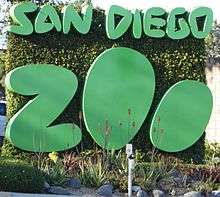Frozen zoo
A frozen zoo is a storage facility in which genetic materials taken from animals (e.g. DNA, sperm, eggs, embryos and live tissue) are stored at very low temperatures (−196 °C) in tanks of liquid nitrogen.[1] Material preserved in this way can be stored indefinitely[2] and used for artificial insemination, in vitro fertilisation, embryo transfer, and cloning. Some facilities also collect and cryopreserve plant material (usually seeds).

The first frozen zoo was established at the San Diego Zoo by pathologist Kurt Benirschke in 1972.[3][4][5] At the time there was no technology available to make use of the collection, but Benirschke believed such technology would be developed in the future.[6] The frozen zoo idea was later supported in Gregory Benford's 1992 paper proposing a Library of Life.[7] Zoos such as the San Diego Zoo and research programs such as the Audubon Center for Research of Endangered Species[8][2] cryopreserve genetic material in order to protect the diversity of the gene pool of endangered species, or to provide for a prospective reintroduction of such extinct species as the Tasmanian tiger[9] and the mammoth.[10]
Gathering material for a frozen zoo is rendered simple by the abundance of sperm in males. Sperm can be taken from an animal following death. The production of eggs, which in females is usually low, can be increased through hormone treatment to obtain 10–20 oocytes, dependent on the species. Some frozen zoos prefer to fertilize eggs and freeze the resulting embryo, as embryos are more resilient under the cryopreservation process.[11] Some centers also collect skin cell samples of endangered animals or extinct species. The Scripps Research Institute has successfully made skin cells into cultures of special cells called induced pluripotent stem cells (IPS cells). It is theoretically possible to make sperm and egg cells from these IPS cells.[4]
Existing frozen zoos
The Frozen Zoo at the San Diego Zoo's Institute for Conservation Research currently stores a collection of 8,400 samples from over 800 species and subspecies.[12] Frozen Zoo at San Diego Zoo Conservation Research has acted as a forbearer to similar projects at other zoos in the United States and Europe.[13][14] However, there are still less than a dozen frozen zoos worldwide.[2]
At the United Arab Emirates' Breeding Centre for Endangered Arabian Wildlife (BCEAW) in Sharjah, the embryos stored include the extremely endangered Gordon’s wildcat (Felis silvestris gordoni) and the Arabian leopard (Panthera pardus nimr) (of which there are only 50 in the wild).[11]
The Audubon Center for Research of Endangered Species, affiliated with the University of New Orleans, is maintaining a frozen zoo. In 2000 the Center implanted a frozen-thawed embryo from the highly endangered African wildcat into the uterus of a domestic house cat, resulting in a healthy male wildcat.[15]
The Frozen Ark is a frozen zoo established in 2004 and jointly managed by the Zoological Society of London, the London Natural History Museum, and the University of Nottingham.[16][17]
The University of Georgia's Regenerative Bioscience Center is building a frozen zoo. RBC Director Steven Stice and animal and dairy science assistant professor Franklin West created the facility with the thought of saving endangered cat species. The scientists have already extracted cells from a Sumatran tiger, which could be used for artificial insemination. Artificial insemination provides a remedy for animals who, due to anatomical or physiological reasons, are unable to reproduce in the natural way. Reproduction of stored genetic material also allows for the fostering of genetic improvements, and the prevention of inbreeding. Modern technology allows for genetic manipulation in animals without keeping them in captivity. However, the success of their restoration into the wild would require the application of new science and a sufficient amount of previously collected material.[11]
See also
- Cryopreservation
- Ex-situ conservation
- Genetic pollution
- Genetic erosion
- Genepool
- Endangered species
- List of conservation topics
- Extinction
- SVF Foundation
- Svalbard Global Seed Vault
References
- Magdalena Pecul (December 1997). "ZAMROŻONE ZOO". „Wiedza i Życie”. Retrieved 2010-04-26.
- "Frozen Zoo". Audubon Nature Institute. Retrieved 2010-04-28.
- Williams, Shawna (September 14, 2018). "Conservation Biologist and Placenta Expert Kurt Benirschke Dies; He established the San Diego Zoo's cryopreserved Frozen Zoo". The Scientist. Retrieved 2 December 2018.
- Harris, Paul (August 28, 2010). "The Frozen Zoo aiming to bring endangered species back from the brink". The Guardian. Retrieved 2 December 2018.
- Dan Collins (2002-10-14). "San Diego's Frozen Zoo". The Associated Press and CBS News. Retrieved 2010-04-28.
- Squarci, Gaia; Cornet, Laurence (February 28, 2017). "Extinct animals find new futures at the 'frozen zoo'". Mashable. Retrieved 2 December 2018.
- Gregory Benford, Nov, 15, 1992. "Saving the Library of Life"
- "Species Survival Center". Audubon Nature Institute. Retrieved 2010-04-28.
- Margit Kossobudzka (2002-10-14). "Wyginął, a teraz powraca". Gazeta Wyborcza.pl. Retrieved 2010-04-26.
- Jan Sochaczewski (2007-10-12). "Zamrożone mamuty powrócą do świata żywych". Dziennik.pl. Retrieved 2011-02-20.
- F.J. de Haas van Dorsser MA VetMB MRCVS. "The Frozen Zoo: Breeding Centre for Endangered Arabian Wildlife, Sharjah, UAE". Arabian Wildlife. Archived from the original on 2010-05-21. Retrieved 2010-04-26.
- "Chill Out: Frozen Zoo Aiding Conservation Projects". San Diego Zoo. Retrieved 2010-04-26.
- "Scientific Meeting - The Frozen Ark Project". ZSL London Zoo. Archived from the original on 2010-10-23. Retrieved 2010-04-26.
- "Welcome to the Frozen Ark". The Frozen Ark Project. Archived from the original on 2015-12-11. Retrieved 2010-04-26.
- "The Frozen Zoo: The University Of New Orleans And The New World Of Saving Endangered Species". Science Daily. March 12, 2001. Retrieved 2 December 2018.
- Kettlewell, Julianna (27 July 2004). "'Frozen Ark' to save animal DNA". BBC News. Retrieved 19 July 2010.
- Johnstone, Helen (27 July 2004). "Endangered species gain a place on Frozen Ark". The Telegraph. Retrieved 19 July 2010.